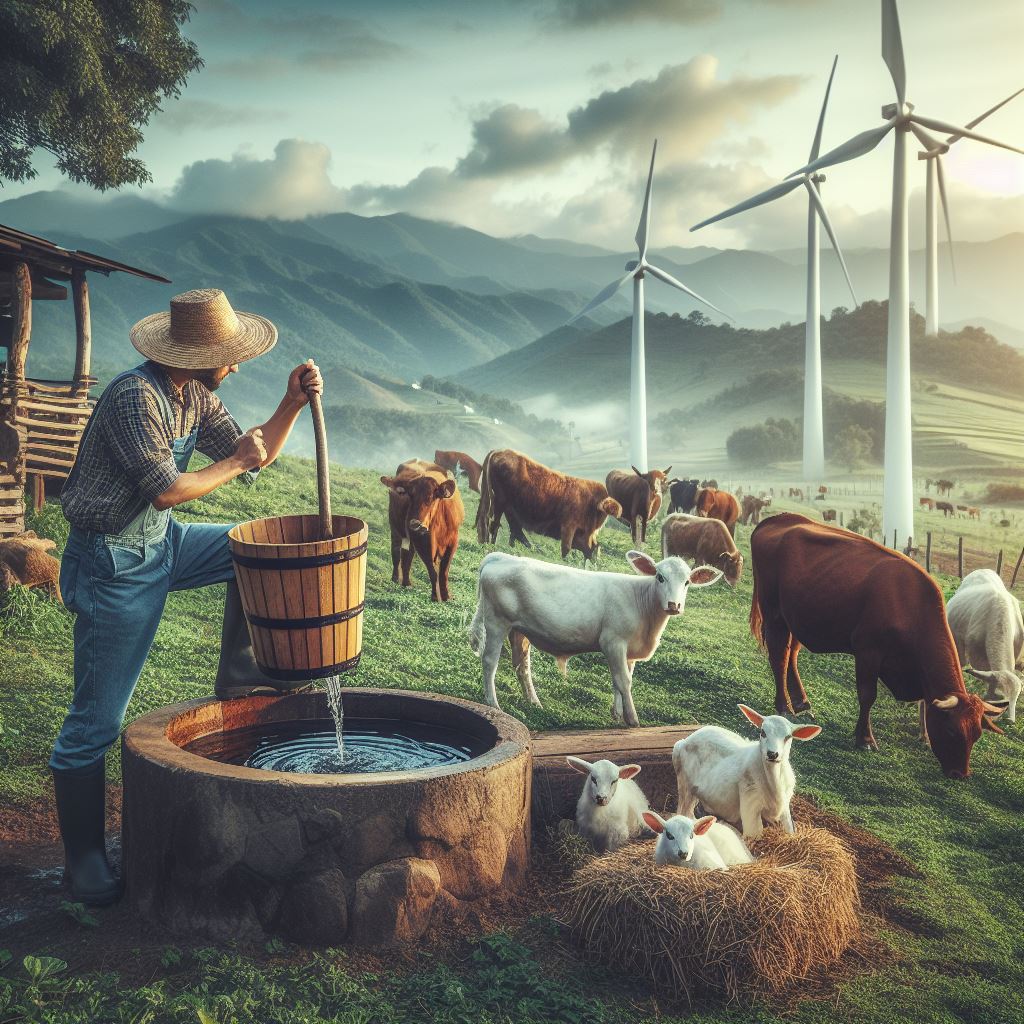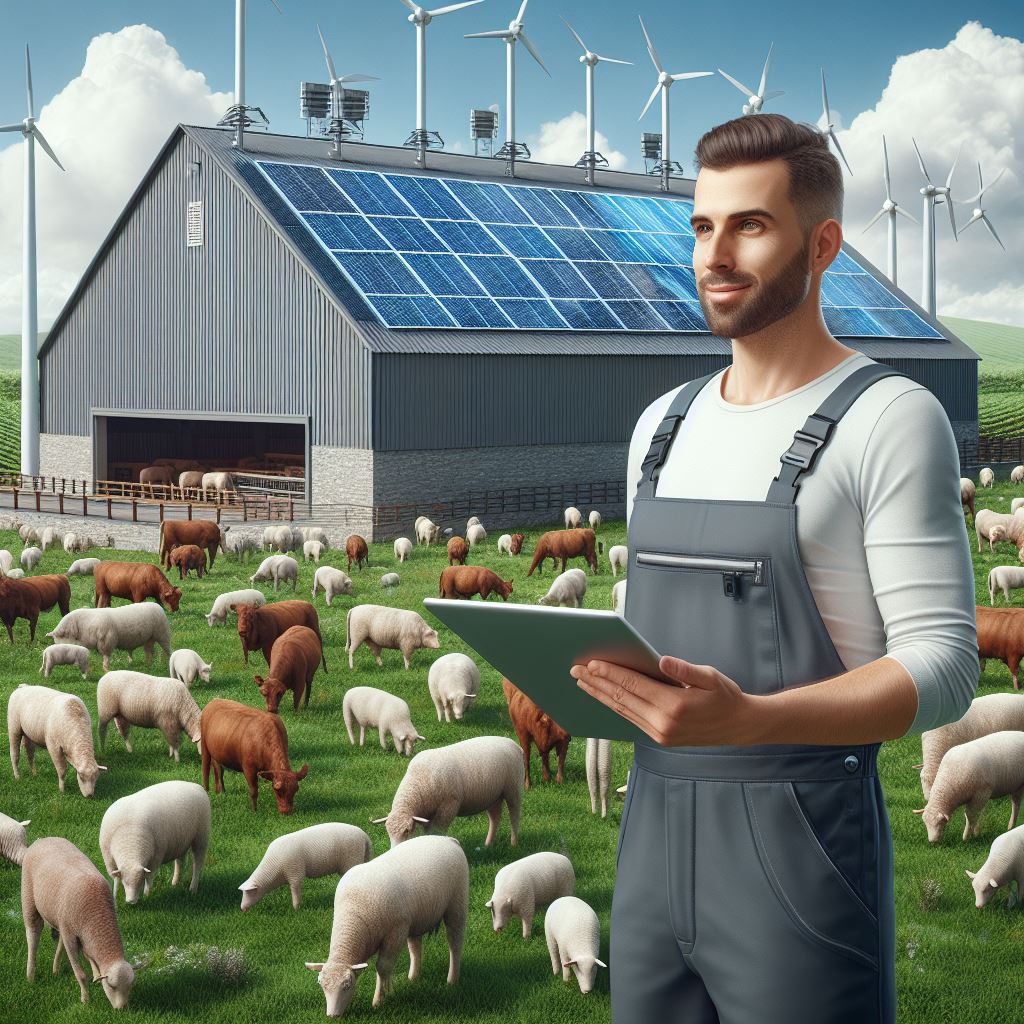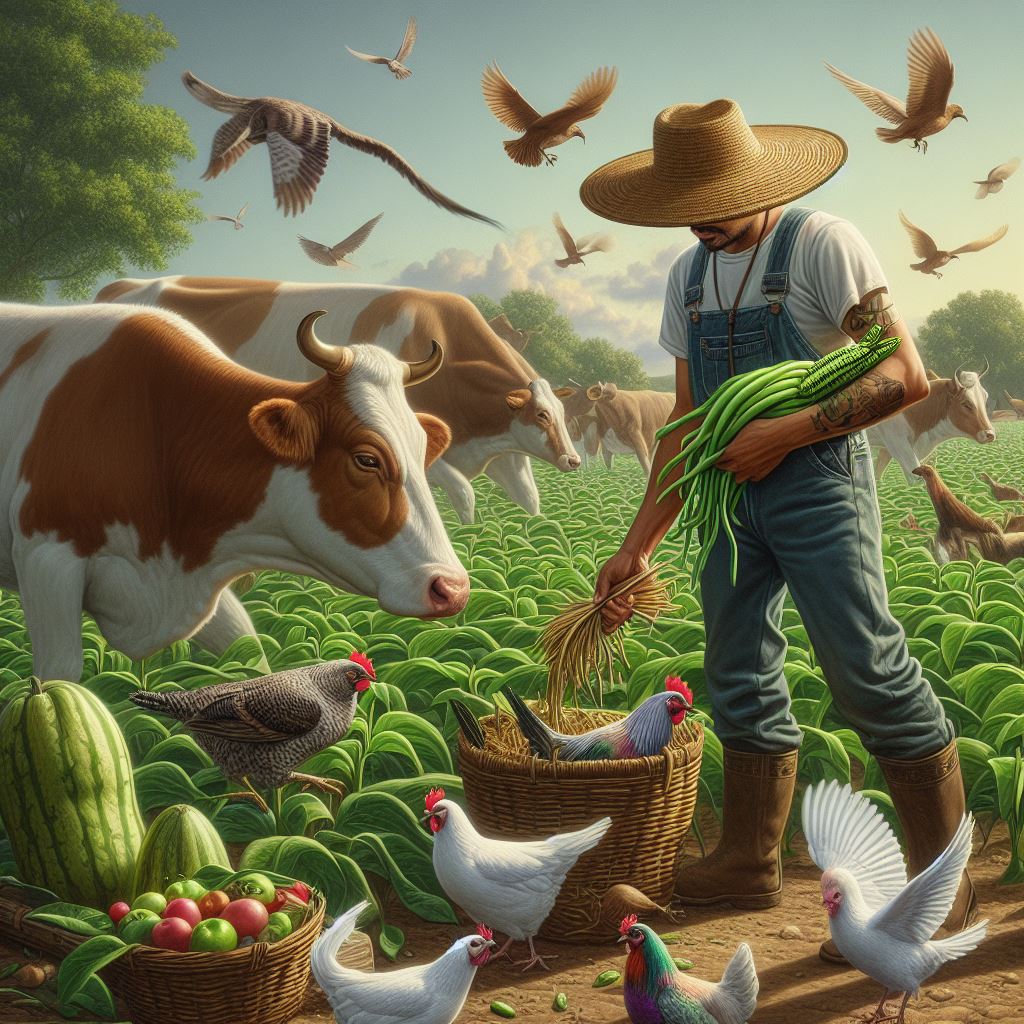Introduction
Importance of sustainable livestock watering
Sustainable livestock watering plays a crucial role in ensuring the well-being and productivity of animals.
Adequate and accessible water sources are vital for their survival and overall health.
Brief overview of the topic
Livestock, including cattle, sheep, and goats, require clean and safe drinking water to maintain their physiological functions.
Water provides essential nutrients, helps with digestion, regulates body temperature, and supports overall growth and reproduction.
Without sustainable livestock watering practices, animals may suffer from dehydration, reduced feed intake, poor weight gain, and increased susceptibility to diseases.
Additionally, water scarcity and poor water quality can negatively impact the environment and other communities relying on the same water sources.
This blog chapter will explore various aspects of sustainable livestock watering, including efficient water management strategies, alternative water sources, and technologies that promote water conservation.
By adopting these practices, livestock farmers can ensure the welfare of their animals while minimizing their environmental footprint.
Stay tuned for the next sections, which will provide detailed insights into sustainable livestock watering, addressing the utilization of rainwater harvesting, rotational grazing, and smart watering systems.
Together, we can promote responsible and sustainable practices that benefit both livestock and the larger ecosystem
Understanding Livestock Watering Needs
Water requirements for different types of livestock
- Cattle: Adult cattle generally need 10-12 gallons of water per day while lactating cows need around 15-20 gallons.
- Sheep and Goats: Adult sheep and goats require 1-4 gallons of water per day.
- Poultry: Chickens and turkeys need about 0.5 to 2 gallons of water per day, depending on their size.
- Swine: Pigs require around 2-5 gallons of water per day, depending on their age and weight.
Factors affecting water intake
- Temperature: High temperatures increase water intake as animals try to cool down.
- Feed type: Animals consuming dry feeds need more water compared to those on high moisture diets.
- Nutritional requirements: High-protein diets can lead to increased water intake.
- Animal activity level: Increased physical activity leads to higher water consumption.
Impact of inadequate water supply on livestock
- Reduced feed intake: Insufficient water leads to decreased appetite, affecting growth and productivity.
- Heat stress: Lack of water impairs the animals’ ability to cool down, leading to heat-related illnesses.
- Reduced milk production: Dairy cows with limited water access produce less milk and suffer dehydration.
- Increased disease risk: Inadequate water supply weakens the animals’ immune system, making them more susceptible to diseases.
- Poor reproductive outcomes: Insufficient water intake can negatively affect fertility and reproductive performance.
- Decreased weight gain: Limited water availability hampers proper digestion and nutrient utilization, reducing weight gain.
- Behavioral issues: Animals may display aggressive or abnormal behaviors when deprived of water.
Furthermore, behavioral problems may arise due to water scarcity. Animals, especially those deprived of water, can display aggression, restlessness, or abnormal behaviors as a response to their distress.
To overcome these challenges, livestock producers must prioritize sustainable livestock watering practices. Providing a constant and ample supply of clean water is crucial.
Access to reliable water sources, such as troughs or automatic waterers, ensures that animals have continuous access to water.
Regularly monitoring water availability and quality is important to avoid contamination or depletion.
In fact, understanding livestock watering needs is vital for ensuring their well-being and productivity.
Transform Your Agribusiness
Unlock your farm's potential with expert advice tailored to your needs. Get actionable steps that drive real results.
Get StartedAdequate water intake is necessary for maintaining proper nutrition, regulating body temperature, and supporting various physiological processes.
Neglecting the water requirements of livestock can lead to significant negative impacts, including reduced feed intake, heat stress, decreased milk production, increased disease risk, poor reproductive outcomes, and decreased weight gain.
By prioritizing sustainable practices and providing sufficient water resources, livestock producers can ensure the health and success of their animals.
Challenges in Livestock Watering
Achieving sustainable livestock watering practices is not without its challenges. This chapter will explore three major challenges faced in this regard:
Seasonal variations and drought conditions
One significant challenge faced in sustainable livestock watering is the seasonal variations and drought conditions that affect water availability.
During dry seasons, water sources become scarce, making it difficult to provide enough water for livestock. This can lead to dehydration and health issues among animals.
Additionally, the irregularity of rainfall can cause water sources to dry up, further exacerbating the problem. Livestock owners must find alternative solutions to ensure water availability during these challenging times.
Limited access to clean and reliable water sources
Another challenge is the limited access to clean and reliable water sources for livestock. In many regions, water sources may be contaminated or not suitable for animal consumption.
This poses a risk to the health and well-being of the livestock.
Inadequate water quality can lead to diseases, reduced productivity, and even death.
Finding clean and reliable water sources is essential for sustainable livestock watering, but it may require additional investments and infrastructure development.
Water conservation concerns
Water conservation is a critical issue when it comes to sustainable livestock watering. Using excessive amounts of water can lead to water scarcity and environmental degradation.
Livestock owners need to be mindful of their water consumption and implement conservation measures.
Implementing efficient watering systems, such as automatic watering systems and drip irrigation, can significantly reduce water wastage.
Additionally, proper management techniques such as rotational grazing can prevent overgrazing and minimize water usage.
Education and awareness about water conservation practices are crucial for livestock owners to understand the importance of sustainable water management and reduce their environmental footprint.
Essentially, sustainable livestock watering faces several significant challenges.
Seasonal variations and drought conditions, limited access to clean water sources, and water conservation concerns all contribute to the complexity of implementing sustainable practices.
However, with innovative solutions and increased awareness, these challenges can be overcome, ensuring a reliable and environmentally conscious approach to livestock watering.
Read: Automated Watering Systems: A Game Changer
Sustainable Livestock Watering Practices
Implementing sustainable livestock watering practices is crucial for preserving water resources and ensuring the well-being of both animals and the environment.
By adopting the following strategies, farmers can minimize water wastage and promote long-term sustainability.
Implementing proper grazing management
Proper grazing management helps optimize water usage by controlling livestock movement and access to water sources.
By rotating grazing areas and implementing rest periods, farmers ensure that animals have access to fresh vegetation and water that supports their hydration needs.
Showcase Your Farming Business
Publish your professional farming services profile on our blog for a one-time fee of $200 and reach a dedicated audience of farmers and agribusiness owners.
Publish Your ProfileDesigning efficient watering systems
1. Importance of water sources location and distribution
Strategically locating water sources near grazing areas minimizes the distance animals have to travel, reducing energy expenditure and water waste.
Distributing multiple water sources ensures equitable access for all animals.
2. Utilizing small-scale watering systems
Using small-scale watering systems allows for more precise water distribution and reduces the chances of overflow or water loss through evaporation.
Examples include troughs, cups, or nipple systems that limit water access to individual animals.
3. Using automatic watering systems
Automated watering systems with sensors and timers help monitor water levels and supply water only as needed.
This avoids overwatering, prevents stagnation, and reduces the risk of water runoff.
Rainwater harvesting and storage techniques
Rainwater harvesting is an eco-friendly way to supplement water supply for livestock. Farmers can collect rainwater from rooftops or land surfaces and store it in tanks or ponds.
This method reduces dependency on external water sources and minimizes strain on aquifers.
Strategies for water quality maintenance
Maintaining water quality is crucial for livestock health and productivity.
Farmers should implement regular testing and treatment of water sources, ensuring safe levels of minerals, contaminants, and microorganisms.
Proper maintenance of watering infrastructure also prevents water contamination.
By implementing sustainable livestock watering practices, farmers contribute to the preservation of water resources, reduce environmental impact, and improve the overall well-being and productivity of their livestock.
Read: Beekeeping Health: Hive Disease Prevention

Benefits of Sustainable Livestock Watering
In this section, we will explore the various benefits of sustainable livestock watering.
Sustainable livestock watering refers to the practice of providing water to livestock in a manner that is efficient, economical, and environmentally friendly.
Environmental advantages
- Conservation of water: Sustainable livestock watering methods help conserve water resources by minimizing wastage and optimizing water use.
- Preservation of water quality: Proper watering techniques prevent contamination of water sources, ensuring the overall well-being of ecosystems.
- Reduced soil erosion: Efficient watering minimizes runoff, preventing soil erosion and the loss of fertile topsoil.
- Preservation of biodiversity: By minimizing water consumption and protecting water sources, sustainable watering practices help preserve the biodiversity of surrounding habitats.
- Mitigation of climate change impacts: Sustainable methods can reduce water-related greenhouse gas emissions, contributing to climate change mitigation efforts.
Economic benefits for farmers
- Cost savings: Sustainable watering methods help farmers reduce their water bills by optimizing water use and minimizing wastage.
- Increased productivity: Providing livestock with clean, adequate water leads to better health and improved productivity, resulting in higher yields for farmers.
- Long-term financial stability: By implementing sustainable watering practices, farmers can ensure the availability of water for their livestock in the long run, reducing the risk of water scarcity and financial losses.
- Regulation compliance: Adhering to sustainable watering practices helps farmers comply with environmental regulations and avoid penalties.
- Access to government incentives: Governments often provide financial incentives and support for farmers who adopt sustainable farming practices, including livestock watering techniques.
Animal health and welfare improvements
- Improved hydration: Sustainable watering methods ensure livestock have access to clean and fresh water, preventing dehydration and related health issues.
- Enhanced digestion: Proper hydration supports proper digestion and nutrient absorption, leading to better overall health and growth for animals.
- Disease prevention: Clean water sources reduce the risk of waterborne diseases and improve overall sanitation for livestock.
- Reduced stress: Adequate water supply contributes to the reduction of stress among animals, promoting their overall well-being and productivity.
- Higher quality products: Well-hydrated and healthier animals produce higher quality meat, milk, and other livestock products, benefiting both farmers and consumers.
Therefore, sustainable livestock watering offers a range of benefits, including environmental advantages, economic benefits for farmers, and improvements in animal health and welfare.
By adopting these practices, farmers can contribute to the sustainable management of water resources while also reaping financial and productivity rewards.
Read: Llama & Alpaca: Preventive Health Tips
Discover More: High-Tech Fencing Solutions for Livestock Safety
Case Studies: Successful Implementation of Sustainable Livestock Watering
Case studies are an essential tool in understanding the successful implementation of sustainable livestock watering practices.
By examining real-world examples, we can gain insights into innovative systems and techniques that help conserve water resources and promote environmental sustainability.
In this section, we will explore two case studies: Wolfe Ranch and Quivira Ranch.
Example 1: Wolfe Ranch’s innovative watering system
1. Description of the system:
Wolfe Ranch has developed a unique watering system that combines advanced technology with traditional practices.
They have installed automated waterers across their pastures, ensuring a constant supply of fresh water to their livestock.
Additionally, they have implemented soil moisture sensors and weather-based controllers to optimize water usage.
2. Benefits observed:
The innovative watering system at Wolfe Ranch has yielded numerous benefits. Firstly, it has significantly reduced water consumption by minimizing wastage and evaporation.
Secondly, it has improved animal health by providing clean and consistent water sources, reducing the risk of diseases.
Thirdly, the automated system has saved labor and time for the ranch, allowing them to focus on other essential tasks.
Example 2: Quivira Ranch’s rainwater harvesting techniques
1. Overview of the methods used:
Quivira Ranch has adopted rainwater harvesting as a key strategy for sustainable livestock watering. They have installed large catchment systems to capture rainwater from roofs and other surfaces.
This harvested water is then stored in tanks or ponds, and a gravity-based distribution system is used to supply water to the livestock.
The ranch also practices effective water management, using low-pressure watering systems to reduce wastage.
2. Positive outcomes:
The rainwater harvesting techniques employed by Quivira Ranch have proven to be highly beneficial. Firstly, they have reduced the dependency on conventional water sources, thus conserving precious freshwater reserves.
Secondly, this sustainable approach has resulted in significant cost savings for the ranch, as they are no longer solely reliant on expensive water supply systems.
Thirdly, the use of rainwater has improved the overall quality of the drinking water for livestock.
These case studies highlight the effectiveness of sustainable livestock watering practices.
By implementing innovative watering systems like Wolfe Ranch and employing rainwater harvesting techniques like Quivira Ranch, we can ensure the responsible utilization of water resources in livestock farming.
These approaches not only benefit the environment but also enhance the productivity and well-being of the livestock.
It is crucial for other ranches and livestock owners to learn from these successful examples and adopt similar sustainable practices for a more sustainable future.
Read: Rabbit Care: Preventing Common Ailments
Conclusion
Recap of the importance of sustainable livestock watering
Water is crucial for livestock, ensuring their health, productivity, and overall well-being.
Showcase Your Farming Business
Publish your professional farming services profile on our blog for a one-time fee of $200 and reach a dedicated audience of farmers and agribusiness owners.
Publish Your ProfileSustainable livestock watering is crucial for environmental conservation and agricultural resilience.
Efficient water management in livestock farming reduces over-extraction from water sources, mitigates environmental degradation, and ensures long-term water availability.
Implementing sustainable practices, such as rainwater harvesting, efficient irrigation, and water recycling, minimizes the industry’s ecological footprint.
This not only preserves natural resources but also enhances the overall resilience of livestock systems to climate change.
Sustainable livestock watering fosters responsible agricultural practices, aligning with global efforts to achieve environmental sustainability and secure food production for future generations.
Emphasis on the need for adoption and implementation
To achieve sustainable livestock watering, farmers must adopt efficient water management practices and technologies.
Final thoughts and call to action
By prioritizing sustainable watering methods, we can conserve water resources, protect the environment, and secure future generations’ food supply. Let’s take action now!



